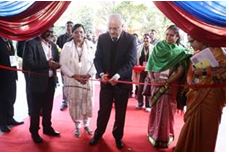



The NAMASTE Yojana, launched in 2022, aims to improve the lives of sanitation workers, including Sewer and Septic Tank Workers and waste pickers. It provides safety gear, health insurance, training, mechanization, and self-employment opportunities, ensuring dignity, safety, and economic empowerment while promoting mechanized cleaning across urban areas.

Copyright infringement not intended
Picture Courtesy: PIB
The Union Minister of State for Social Justice and Empowerment presides over a Special Programme focused on 'NAMASTE Yojana', to honour Sanitation Workers.
The National Action for Mechanized Sanitation Ecosystem (NAMASTE) was launched in 2022 by the Ministry of Social Justice and Empowerment (MoSJE) and the Ministry of Housing and Urban Affairs (MoHUA).
It aims to improve the lives of sanitation workers, particularly Sewer and Septic Tank Workers (SSWs) and, since 2024, waste pickers. The scheme focuses on ensuring their safety, dignity, and economic empowerment by promoting mechanized cleaning and reducing hazardous manual work.
It replaces the earlier Self-Employment Scheme for Rehabilitation of Manual Scavengers (SRMS) and targets all 4,800+ Urban Local Bodies (ULBs) in India by 2025-26.
Identifies Workers: The scheme profiles Sewer and Septic Tank Workers (SSWs) across cities to understand their needs. 73,768 SSWs have been profiled in 3,326 ULBs, as of May 2025,
Provides Safety Gear: It distributes Personal Protective Equipment (PPE) kits, including masks, gloves, goggles, and gowns, to protect workers from health hazards. So far, 45,871 workers have received PPE kits, and 354 have gotten additional safety devices.
Ensures Health Insurance: The scheme enrolls workers and their families in the Ayushman Bharat-Pradhan Mantri Jan Arogya Yojana (AB-PMJAY), offering up to Rs. 5 lakh per family annually for healthcare. By May 2025, 27,103 workers have received Ayushman cards.
Promotes Self-Employment: It supports workers to start their own businesses by providing capital subsidies and equipment like sewing machines or sanitation vehicles.
Trains Workers: The scheme offers occupational safety training and skill development to make workers skilled “sanipreneurs” (sanitation entrepreneurs). Training lasts up to two years with a Rs. 3,000 monthly stipend.
Encourages Mechanization: It promotes machines for cleaning sewers and septic tanks to eliminate dangerous manual scavenging. By 2025, 9,894 mechanized cleaning machines have been introduced across ULBs.
Must Read Articles:
Source:
|
PRACTICE QUESTION Q. The dignity of labor remains a distant dream for sanitation workers in many parts of India. Discuss the socio-economic barriers that prevent their integration into mainstream development narratives. 150 words |








© 2025 iasgyan. All right reserved